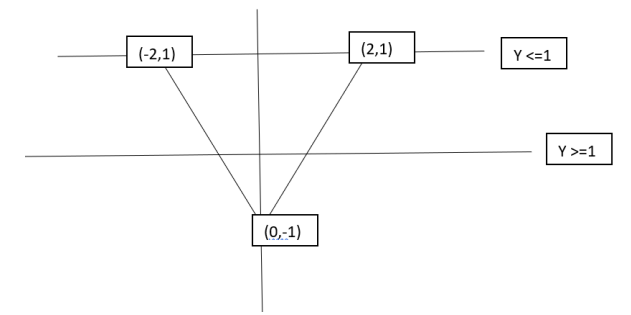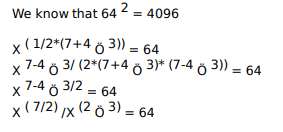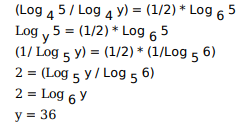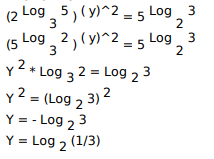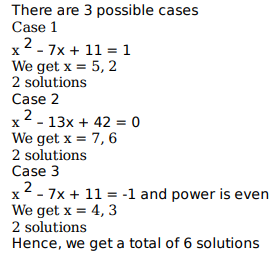Live Updates
• CATKing has launched new chat bot.

• New video on Logs has been released.
495
Learners
asked the doubt

Previous Year Questions
If f(5 + x) = f(5 – x) for every real x, and f (x) = 0 has four distinct real roots, then the sum of these roots is
Video Explanation

Explanatory Answer
As f(x) = 0 we must try to convert f(5+x) = f(5-x) in terms of f(x)
We substitute x as x-5
f(x) = f(10-x)
Lets assume x = A as a root, then we simultaneously get 10-A as a root
Similarly we assume x = B as a root, then we get 10-B as a root
the 4 roots are A, B, 10-A, 10-B
The sum of roots is 20
Veeru invested Rs 10000 at 5% simple annual interest, and exactly after two years, Joy invested Rs 8000 at 10% simple annual interest. How many years after Veeru’s investment, will their balances, i.e., principal plus accumulated interest, be equal?
Video Explanation

Explanatory Answer
2 years simple interest accrued by Veeru is Rs. 1000
10000 + 1000 + 10000*0.05*x = 8000 + 8000*0.1*x
3000 = 300x
x = 10 years
2 years of Veeru’s initial investment hence answer = 10+2 = 12 years
Let A, B and C be three positive integers such that the sum of A and the mean of B and C is 5. In addition, the sum of B and the mean of A and C is 7. Then the sum of A and B is
Video Explanation

Explanatory Answer
A + (B+C)/2 = 5 à 2A + B + C = 10 - Eq 1
B + (A+C)/2 = 7 à A + 2B + C = 14 - Eq 2
Subtracting, Eq2 – Eq1
B = 4 + A
Adding Eq 1 and Eq 2
3(A+B) + 2C = 24 – Eq 3
Now since A B C are positive and B = 4 + A hence A+B cannot be equal to 4
In Eq 3 all components have to be even thereby eliminating 5 and 7.
Hence A+B = 6.
Two persons are walking beside a railway track at respective speeds of 2 and 4 km per hour in the same direction. A train came from behind them and crossed them in 90 and 100 seconds, respectively. The time, in seconds, taken by the train to cross an electric post is nearest to
Video Explanation

Explanatory Answer
Assume length of Train as L and Original speed as S
To cross the first person (2 kmph) train needs 90 seconds at S-2 km/hr and to cross the second
person (2 kmph) train needs 100 seconds at S-4 km/hr
Speeds are inversely proportional to time
(S-2)/(S-4) = (100/90)
S = 22
(S-2) = L * 3600 / 90
L = 0.5 km
T = (0.5 * 3600) / 22 = 82 seconds
A straight road connects points A and B. Car 1 travels from A to B and Car 2 travels from B to A, both leaving at the same time. After meeting each other, they take 45 minutes and 20 minutes, respectively, to complete their journeys. If Car 1 travels at the speed of 60 km/hr, then the speed of Car 2, in km/hr, is
Video Explanation

Explanatory Answer

A person spent Rs 50000 to purchase a desktop computer and a laptop computer. He sold the desktop at 20% profit and the laptop at 10% loss. If overall he made a 2% profit then the purchase price, in rupees, of the desktop is
Video Explanation

Explanatory Answer
Cost of Desktop = D
Cost of Laptop = L
D + L = 50000 à Eq 1
1.2*D + 0.9*L = 51000 à Eq 2
Multiplying Eq 1 by 0.9 and subtracting with Eq 2
0.3*D = 6000
D = Rs. 20000
On a rectangular metal sheet of area 135 sq in, a circle is painted such that the circle touches two opposite sides. If the area of the sheet left unpainted is two-thirds of the painted area then the perimeter of the rectangle in inches is:
Video Explanation

Explanatory Answer

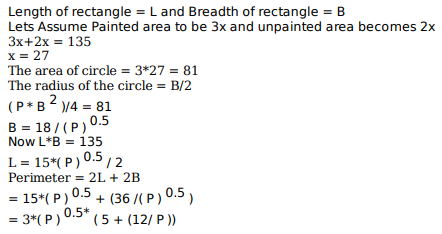
A circle is inscribed in a rhombus with diagonals 12 cm and 16 cm. The ratio of the area of circle to the area of rhombus is:
Video Explanation

Explanatory Answer
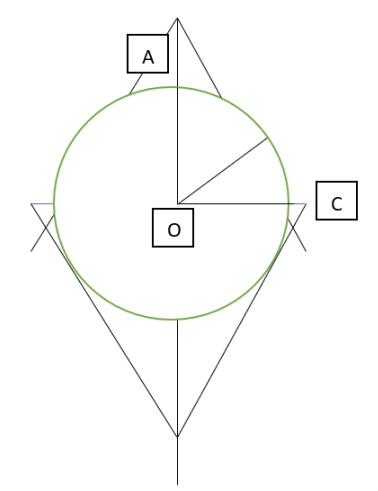
AOC is a right-angle triangle and AC = 10
Perpendicular of a right-angle triangle = P*B/H = 8*6 / 10 = 4.8
Area of circle = P *4.8*4.8 / (0.5*12*16) = 6* P / 25
A gentleman decided to treat a few children in the following manner. He gives half of his total stock of toffees and one extra to the first child, and then the half of the remaining stock along with one extra to the second and continues giving away in this fashion. His total stock exhausts after he takes care of 5 children. How many toffees were there in his stock initially?
Video Explanation

Explanatory Answer
These questions work with a backward approach.
The 5 child gets half of what was remaining after 4 child + 1, this essentially means the 5 child
got 2 toffees.
Now the gentleman had 2 toffees after giving half of what was remaining after child 3 + 1, this
means he had 2*(2+1) = 6 left after giving the third child. Hence the 4-child got
0.5*6 + 1 = 4 and 2 were left for 5-child.
Similarly, after giving second child he had 2*(6+1) = 14 toffees
After giving first child he had 2*(14+1) = 30 toffees
Initially he had 2*(30+1) = 62 toffees
The mean of all 4 digit even natural numbers of the form 'aabb', where a>0, is
Video Explanation

Explanatory Answer
The even numbers will be of the form
1100, 1122, 1144, 1166, 1188
2200, 2222, 2244, 2266, 2288 and so on
There will be 45 such numbers from 1100 to 9988, the mean will be the 23 number which is 5544
An alloy is prepared by mixing three metals A, B and C in the proportion 3:4:7 by volume. Weights of the same volume of the metals A, B and C are in the ratio 5:2:6. In 130 kg of the alloy, the weight, in kg, of the metal C is:
Video Explanation

Explanatory Answer
We have been given the ratio of the volume and weights of the volume (1-unit cube of A will
have a weight of 5x).
Hence to find the actual weights we must multiply the volume and weights of volume.
A : B : C = (3*5 : 4*2 : 7*6) = 15 : 8 : 42
Total weight = 15x + 8x + 42x = 65x = 130
x = 2
Therefore weight of C = 42*2 = 84 Kgs
A solution, of volume 40 litres, has dye and water in the proportion 2 : 3. Water is added to the solution to change this proportion to 2 : 5. If one-fourths of this diluted solution is taken out, how many litres of dye must be added to the remaining solution to bring the proportion back to 2 : 3?
Video Explanation

Explanatory Answer
Solution = 40 litres
Dye = 16 litres
Water = 24 litres
New amount of water in the solution will be 5*8 = 40 litres, i.e 16 litres of water has been added
Solution = 56 litres
We remove ¼ or 14 litres, which leaves 42 litres with dye = 12 litres and water = 30 litres
We need 8 litres of dye to get the proportion to 2:3
In a group of people, 28% of the members are young while the rest are old. If 65% of the members are literates, and 25% of the literates are young, then the percentage of old people among the illiterates is nearest to
Video Explanation

Explanatory Answer
Let’s Assume there are 400 people
Young – 112
Old – 288
Illiterates = 140
Literates = 260
Young literate = 65
Old Literates = 195
Old illiterates = 93
Old illiterates / Total illiterates = 93/140 = 66%
How many 3-digit numbers are there, for which the product of their digits is more than 2 but less than 7?
Video Explanation

Explanatory Answer
Let’s start with numbers with products 3 4 5 6
113, 131, 311
122, 212, 221
114, 141, 411
115, 151, 511
123, 132, 213, 312, 231, 321
116, 161, 611
21 Solutions
Leaving home at the same time, Amal reaches office at 10:15 am if he travels at 8 km/hr, and at 9:40 am if he travels at 15 km/hr. Leaving home at 9:10 am, at what speed, in km/hr, must he travel so as to reach office exactly at 10 am?
Video Explanation

Explanatory Answer
At 8 km/hr Amal reaches at 10:15 am and at 15km/hr Amal reaches at 9:40 am.
Lets assume the original time takes as T mins and at 15km/hr the time taken would be T-35 mins
Ratio of speeds is inverse of ratio of time.
(8/15) = (T-35/T)
T = 75 mins
Distance = 8 * (75/60) = 10 kms
Time = (50/60) hr
Speed = 10 * (50/60) = 12 km/hr
Which of the following statements is FALSE?
Video Explanation

Explanatory Answer
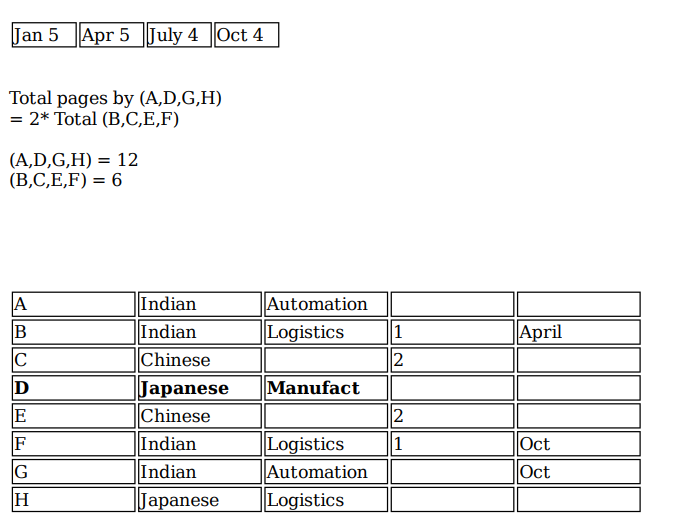
From statement 3, Japanese and chinese did not belong to automation à A is indian
From statement 7, B and G belong to the same country and D is from Japan.
à Band G can be Indans only. Alos, H will be Japanese
From 5, E and C had some no. of papers, also E has consecutive papers i.e E wrote 2 papers
which means C also wrote 2 pages. Thus B wrote 1 paper as sum (B,C,E,F)= 6
From 3, G can belong to automation
From stat5, C and E are from different areas which can be either of manufacturing and logistics,
thus H is from Logistics
Now A cannot publish in October
H cannot publish in oct as H & A publish in same months
G cannot publish in April as B publish in April
D cannot publish in July.
Thus none of the 4 authors can publish in 4 issues, that means they publish 3 papers each.
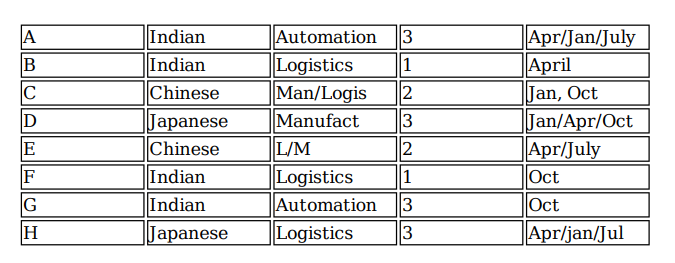
There were exactly two papers by authors from Manufacturing area in the July issue is false.
Which of the following is the correct sequence of number of papers by authors from Automation, Manufacturing and Logistics areas, respectively?
Video Explanation

Explanatory Answer

From statement 3, Japanese and chinese did not belong to automation à A is indian
From statement 7, B and G belong to the same country and D is from Japan.
à Band G can be Indans only. Alos, H will be Japanese
From 5, E and C had some no. of papers, also E has consecutive papers i.e E wrote 2 papers
which means C also wrote 2 pages. Thus B wrote 1 paper as sum (B,C,E,F)= 6
From 3, G can belong to automation
From stat5, C and E are from different areas which can be either of manufacturing and logistics,
thus H is from Logistics
Now A cannot publish in October
H cannot publish in oct as H & A publish in same months
G cannot publish in April as B publish in April
D cannot publish in July.
Thus none of the 4 authors can publish in 4 issues, that means they publish 3 papers each.

6, 5, 7 is the correct sequence of number of papers by authors from Automation, Manufacturing
and Logistics areas, respectively.
A journal plans to publish 18 research papers, written by eight authors (A, B, C, D, E, F, G, and H) in four issues of the journal scheduled in January, April, July and October. Each of the research papers was written by exactly one of the eight authors. Five papers were scheduled in each of the first two issues, while four were scheduled in each of the last two issues. Every author wrote at least one paper and at most three papers. The total number of papers written by A, D, G and H was double the total number of papers written by the other four authors. Four of the authors were from India and two each were from Japan and China. Each author belonged to exactly one of the three areas — Manufacturing, Automation and Logistics. Four of the authors were from the Logistics area and two were from the Automation area. As per the journal policy, none of the authors could have more than one paper in any issue of the journal.
The following facts are also known.
1. F, an Indian author from the Logistics area, wrote only one paper. It was scheduled in the October issue.
2. A was from the Automation area and did not have a paper scheduled in the October issue.
3. None of the Indian authors were from the Manufacturing area and none of the Japanese or Chinese authors were from the Automation area.
4. A and H were from different countries, but had their papers scheduled in exactly the same issues.
5. C and E, both Chinese authors from different areas, had the same number of papers scheduled. Further, E had papers scheduled in consecutive issues of the journal but C did not.
6. B, from the Logistics area, had a paper scheduled in the April issue of the journal.
7. B and G belonged to the same country. None of their papers were scheduled in the same issue of the journal.
8. D, a Japanese author from the Manufacturing area, did not have a paper scheduled in the July issue.
9. C and H belonged to different areas.
What is the correct sequence of number of papers written by B, C, E and G, respectively?
Video Explanation

Explanatory Answer

From statement 3, Japanese and chinese did not belong to automation à A is indian
From statement 7, B and G belong to the same country and D is from Japan.
à Band G can be Indans only. Alos, H will be Japanese
From 5, E and C had some no. of papers, also E has consecutive papers i.e E wrote 2 papers
which means C also wrote 2 pages. Thus B wrote 1 paper as sum (B,C,E,F)= 6
From 3, G can belong to automation
From stat5, C and E are from different areas which can be either of manufacturing and logistics,
thus H is from Logistics
Now A cannot publish in October
H cannot publish in oct as H & A publish in same months
G cannot publish in April as B publish in April
D cannot publish in July.
Thus none of the 4 authors can publish in 4 issues, that means they publish 3 papers each.

E publish in April and July as C cannot publish consecutive months.
1, 2, 2, 3 is the correct sequence of number of papers written by B, C, E and G, respectively
How many papers were written by Indian authors?
Video Explanation

Explanatory Answer

From statement 3, Japanese and chinese did not belong to automation à A is indian
From statement 7, B and G belong to the same country and D is from Japan.
à Band G can be Indans only. Alos, H will be Japanese
From 5, E and C had some no. of papers, also E has consecutive papers i.e E wrote 2 papers
which means C also wrote 2 pages. Thus B wrote 1 paper as sum (B,C,E,F)= 6
From 3, G can belong to automation
From stat5, C and E are from different areas which can be either of manufacturing and logistics,
thus H is from Logistics
Now A cannot publish in October
H cannot publish in oct as H & A publish in same months
G cannot publish in April as B publish in April
D cannot publish in July.
Thus none of the 4 authors can publish in 4 issues, that means they publish 3 papers each.

8 papers were written by Indian authors.
Which of the following statement(s) MUST be true?
Statement A: Every issue had at least one paper by author(s) from each country.
Statement B: Every issue had at most two papers by author(s) from each area.
Video Explanation

Explanatory Answer

From statement 3, Japanese and chinese did not belong to automation à A is indian
From statement 7, B and G belong to the same country and D is from Japan.
à Band G can be Indans only. Alos, H will be Japanese
From 5, E and C had some no. of papers, also E has consecutive papers i.e E wrote 2 papers
which means C also wrote 2 pages. Thus B wrote 1 paper as sum (B,C,E,F)= 6
From 3, G can belong to automation
From stat5, C and E are from different areas which can be either of manufacturing and logistics,
thus H is from Logistics
Now A cannot publish in October
H cannot publish in oct as H & A publish in same months
G cannot publish in April as B publish in April
D cannot publish in July.
Thus none of the 4 authors can publish in 4 issues, that means they publish 3 papers each.

Statement A: Every issue had at least one paper by author(s) from each country – Ture
Statement B: Every issue had at most two papers by author(s) from each area. – Not True
Which of the following statements is FALSE?
Video Explanation

Explanatory Answer

From statement 3, Japanese and chinese did not belong to automation à A is indian
From statement 7, B and G belong to the same country and D is from Japan.
à Band G can be Indans only. Alos, H will be Japanese
From 5, E and C had some no. of papers, also E has consecutive papers i.e E wrote 2 papers
which means C also wrote 2 pages. Thus B wrote 1 paper as sum (B,C,E,F)= 6
From 3, G can belong to automation
From stat5, C and E are from different areas which can be either of manufacturing and logistics,
thus H is from Logistics
Now A cannot publish in October
H cannot publish in oct as H & A publish in same months
G cannot publish in April as B publish in April
D cannot publish in July.
Thus none of the 4 authors can publish in 4 issues, that means they publish 3 papers each.

Every issue had exactly two papers by authors from Logistics area Is not true.
Which of the following statements is FALSE?
Video Explanation

Explanatory Answer

From statement 3, Japanese and chinese did not belong to automation à A is indian
From statement 7, B and G belong to the same country and D is from Japan.
à Band G can be Indans only. Alos, H will be Japanese
From 5, E and C had some no. of papers, also E has consecutive papers i.e E wrote 2 papers
which means C also wrote 2 pages. Thus B wrote 1 paper as sum (B,C,E,F)= 6
From 3, G can belong to automation
From stat5, C and E are from different areas which can be either of manufacturing and logistics,
thus H is from Logistics
Now A cannot publish in October
H cannot publish in oct as H & A publish in same months
G cannot publish in April as B publish in April
D cannot publish in July.
Thus none of the 4 authors can publish in 4 issues, that means they publish 3 papers each.

There were exactly two papers by authors from Manufacturing area in the July issue is false.
Which of the following is the correct sequence of number of papers by authors from Automation, Manufacturing and Logistics areas, respectively?
Video Explanation

Explanatory Answer

From statement 3, Japanese and chinese did not belong to automation à A is indian
From statement 7, B and G belong to the same country and D is from Japan.
à Band G can be Indans only. Alos, H will be Japanese
From 5, E and C had some no. of papers, also E has consecutive papers i.e E wrote 2 papers
which means C also wrote 2 pages. Thus B wrote 1 paper as sum (B,C,E,F)= 6
From 3, G can belong to automation
From stat5, C and E are from different areas which can be either of manufacturing and logistics,
thus H is from Logistics
Now A cannot publish in October
H cannot publish in oct as H & A publish in same months
G cannot publish in April as B publish in April
D cannot publish in July.
Thus none of the 4 authors can publish in 4 issues, that means they publish 3 papers each.

6, 5, 7 is the correct sequence of number of papers by authors from Automation, Manufacturing
and Logistics areas, respectively.
What is the correct sequence of number of papers written by B, C, E and G, respectively?
Video Explanation

Explanatory Answer

From statement 3, Japanese and chinese did not belong to automation à A is indian
From statement 7, B and G belong to the same country and D is from Japan.
à Band G can be Indans only. Alos, H will be Japanese
From 5, E and C had some no. of papers, also E has consecutive papers i.e E wrote 2 papers
which means C also wrote 2 pages. Thus B wrote 1 paper as sum (B,C,E,F)= 6
From 3, G can belong to automation
From stat5, C and E are from different areas which can be either of manufacturing and logistics,
thus H is from Logistics
Now A cannot publish in October
H cannot publish in oct as H & A publish in same months
G cannot publish in April as B publish in April
D cannot publish in July.
Thus none of the 4 authors can publish in 4 issues, that means they publish 3 papers each.

E publish in April and July as C cannot publish consecutive months.
1, 2, 2, 3 is the correct sequence of number of papers written by B, C, E and G, respectively
How many papers were written by Indian authors?
Video Explanation

Explanatory Answer

From statement 3, Japanese and chinese did not belong to automation à A is indian
From statement 7, B and G belong to the same country and D is from Japan.
à Band G can be Indans only. Alos, H will be Japanese
From 5, E and C had some no. of papers, also E has consecutive papers i.e E wrote 2 papers
which means C also wrote 2 pages. Thus B wrote 1 paper as sum (B,C,E,F)= 6
From 3, G can belong to automation
From stat5, C and E are from different areas which can be either of manufacturing and logistics,
thus H is from Logistics
Now A cannot publish in October
H cannot publish in oct as H & A publish in same months
G cannot publish in April as B publish in April
D cannot publish in July.
Thus none of the 4 authors can publish in 4 issues, that means they publish 3 papers each.

8 papers were written by Indian authors.
Which of the following statement(s) MUST be true?
Statement A: Every issue had at least one paper by author(s) from each country.
Statement B: Every issue had at most two papers by author(s) from each area.
Video Explanation

Explanatory Answer

From statement 3, Japanese and chinese did not belong to automation à A is indian
From statement 7, B and G belong to the same country and D is from Japan.
à Band G can be Indans only. Alos, H will be Japanese
From 5, E and C had some no. of papers, also E has consecutive papers i.e E wrote 2 papers
which means C also wrote 2 pages. Thus B wrote 1 paper as sum (B,C,E,F)= 6
From 3, G can belong to automation
From stat5, C and E are from different areas which can be either of manufacturing and logistics,
thus H is from Logistics
Now A cannot publish in October
H cannot publish in oct as H & A publish in same months
G cannot publish in April as B publish in April
D cannot publish in July.
Thus none of the 4 authors can publish in 4 issues, that means they publish 3 papers each.

Statement A: Every issue had at least one paper by author(s) from each country – Ture
Statement B: Every issue had at most two papers by author(s) from each area. – Not True
Which of the following statements is FALSE?
Video Explanation

Explanatory Answer

From statement 3, Japanese and chinese did not belong to automation à A is indian
From statement 7, B and G belong to the same country and D is from Japan.
à Band G can be Indans only. Alos, H will be Japanese
From 5, E and C had some no. of papers, also E has consecutive papers i.e E wrote 2 papers
which means C also wrote 2 pages. Thus B wrote 1 paper as sum (B,C,E,F)= 6
From 3, G can belong to automation
From stat5, C and E are from different areas which can be either of manufacturing and logistics,
thus H is from Logistics
Now A cannot publish in October
H cannot publish in oct as H & A publish in same months
G cannot publish in April as B publish in April
D cannot publish in July.
Thus none of the 4 authors can publish in 4 issues, that means they publish 3 papers each.

Every issue had exactly two papers by authors from Logistics area Is not true.
Ganga, Kaveri, and Narmada are three women who buy four raw materials (Mango, Apple, Banana and Milk) and sell five finished products (Mango smoothie, Apple smoothie, Banana smoothie, Mixed fruit smoothie and Fruit salad). Table-1 gives information about the raw materials required to produce the five finished products. One unit of a finished product requires one unit of each of the raw materials mentioned in the second column of the table.
Table-1
| Finished product | Raw materials required |
| Mango smoothie | Mango, Milk |
| Apple smoothie | Apple, Milk |
| Banana smoothie | Banana, Milk |
| Mixed fruit smoothie | Mango, Apple, Banana, Milk |
| Fruit salad | Mango, Apple, Banana |
One unit of milk, mango, apple, and banana cost ₹5, ₹3, ₹2, and ₹1 respectively. Each unit of a finished product is sold for a profit equal to two times the number of raw materials used to make that product. For example, apple smoothie is made with two raw materials (apple and milk) and will be sold for a profit of ₹4 per unit. Leftover raw materials are sold during the last business hour of the day for a loss of ₹1 per unit.
The amount, in rupees, received from sales (revenue) for each woman in each of the four business hours of the day is given in Table-2.
Table-2
| Business Hour | Ganga | Kaveri | Narmada |
| Hour 1 | 23 | 19 | 31 |
| Hour 2 | 21 | 22 | 21 |
| Hour 3 | 29 | 30 | 23 |
| Hour 4 (last hour) | 30 | 27 | 22 |
The following additional facts are known.
1. No one except possibly Ganga sold any Mango smoothie.
2. Each woman sold either zero or one unit of any single finished product in any hour.
3. Each woman had exactly one unit each of two different raw materials as leftovers.
4. No one had any banana leftover.
What BEST can be concluded about the number of units of fruit salad sold in the first hour?
Video Explanation

Explanatory Answer

GANGA
Hour 1 = 23 Mango + Apple = 12+11
Fruit salad + Apple = 12+11
Hour 2 = 21 Apple + Banana = 11+10
Hour 3 = 29 Banana + MFS = 10+19
Hour 4 = 30 Mango+ Fruit S+ Leftover milk+ leftover mango
= 12+12+4+2 = 30
KAVERI
Hour 1 = 19 Mixed fruit smoothies
Hour 2 = 22 Fruit S + Banana = 10+12
Hour 3 = 29 Apple + MFS = 11+19
Hour 4 = 27 Mango+ Apple+ milk+ Banana
= 11+10+4+2 = 27
OR Banana+ fruit +milk + apple = 10+12+4+2=27
NARMADA
Hour 1 = 31 Mixed fruit smoothies + Fruit salad = 19+12
Hour 2 = 21 Apple + Banana = 11+10
Hour 3 = 23 Apple + Fruit = 11+12
Hour 4 = 22 MFS + Left mango + left apple
= 19+2+1 = 22
Narmada must sell a fruit salad
Ganga may or may not sell fruit salad
è Either 1 or 2
Which of the following is NECESSARILY true?
Video Explanation

Explanatory Answer

GANGA
Hour 1 = 23 Mango + Apple = 12+11
Fruit salad + Apple = 12+11
Hour 2 = 21 Apple + Banana = 11+10
Hour 3 = 29 Banana + MFS = 10+19
Hour 4 = 30 Mango+ Fruit S+ Leftover milk+ leftover mango
= 12+12+4+2 = 30
KAVERI
Hour 1 = 19 Mixed fruit smoothies
Hour 2 = 22 Fruit S + Banana = 10+12
Hour 3 = 29 Apple + MFS = 11+19
Hour 4 = 27 Mango+ Apple+ milk+ Banana
= 11+10+4+2 = 27
OR Banana+ fruit +milk + apple = 10+12+4+2=27
NARMADA
Hour 1 = 31 Mixed fruit smoothies + Fruit salad = 19+12
Hour 2 = 21 Apple + Banana = 11+10
Hour 3 = 23 Apple + Fruit = 11+12
Hour 4 = 22 MFS + Left mango + left apple
= 19+2+1 = 22
Validating all the options from above data, Option C is the only option necessarily TRUE
What BEST can be concluded about the total number of units of milk the three women had in the beginning?
Video Explanation

Explanatory Answer

GANGA
Hour 1 = 23 Mango + Apple = 12+11
Fruit salad + Apple = 12+11
Hour 2 = 21 Apple + Banana = 11+10
Hour 3 = 29 Banana + MFS = 10+19
Hour 4 = 30 Mango+ Fruit S+ Leftover milk+ leftover mango
= 12+12+4+2 = 30
KAVERI
Hour 1 = 19 Mixed fruit smoothies
Hour 2 = 22 Fruit S + Banana = 10+12
Hour 3 = 29 Apple + MFS = 11+19
Hour 4 = 27 Mango+ Apple+ milk+ Banana
= 11+10+4+2 = 27
OR Banana+ fruit +milk + apple = 10+12+4+2=27
NARMADA
Hour 1 = 31 Mixed fruit smoothies + Fruit salad = 19+12
Hour 2 = 21 Apple + Banana = 11+10
Hour 3 = 23 Apple + Fruit = 11+12
Hour 4 = 22 MFS + Left mango + left apple
= 19+2+1 = 22

If it is known that three leftover units of mangoes were sold during the last business hour of the day, how many apple smoothies were sold during the day?
Video Explanation

Explanatory Answer

GANGA
Hour 1 = 23 Mango + Apple = 12+11
Fruit salad + Apple = 12+11
Hour 2 = 21 Apple + Banana = 11+10
Hour 3 = 29 Banana + MFS = 10+19
Hour 4 = 30 Mango+ Fruit S+ Leftover milk+ leftover mango
= 12+12+4+2 = 30
KAVERI
Hour 1 = 19 Mixed fruit smoothies
Hour 2 = 22 Fruit S + Banana = 10+12
Hour 3 = 29 Apple + MFS = 11+19
Hour 4 = 27 Mango+ Apple+ milk+ Banana
= 11+10+4+2 = 27
OR Banana+ fruit +milk + apple = 10+12+4+2=27
NARMADA
Hour 1 = 31 Mixed fruit smoothies + Fruit salad = 19+12
Hour 2 = 21 Apple + Banana = 11+10
Hour 3 = 23 Apple + Fruit = 11+12
Hour 4 = 22 MFS + Left mango + left apple
= 19+2+1 = 22
Ganga and Narmada already have leftover mangoes
for Kaveri we will consider Case 1 in hour 4
à 6 apple smoothies were sold
What BEST can be concluded about the number of units of fruit salad sold in the first hour?
Video Explanation

Explanatory Answer

GANGA
Hour 1 = 23 Mango + Apple = 12+11
Fruit salad + Apple = 12+11
Hour 2 = 21 Apple + Banana = 11+10
Hour 3 = 29 Banana + MFS = 10+19
Hour 4 = 30 Mango+ Fruit S+ Leftover milk+ leftover mango
= 12+12+4+2 = 30
KAVERI
Hour 1 = 19 Mixed fruit smoothies
Hour 2 = 22 Fruit S + Banana = 10+12
Hour 3 = 29 Apple + MFS = 11+19
Hour 4 = 27 Mango+ Apple+ milk+ Banana
= 11+10+4+2 = 27
OR Banana+ fruit +milk + apple = 10+12+4+2=27
NARMADA
Hour 1 = 31 Mixed fruit smoothies + Fruit salad = 19+12
Hour 2 = 21 Apple + Banana = 11+10
Hour 3 = 23 Apple + Fruit = 11+12
Hour 4 = 22 MFS + Left mango + left apple
= 19+2+1 = 22
Narmada must sell a fruit salad
Ganga may or may not sell fruit salad
è Either 1 or 2
Which of the following is NECESSARILY true?
Video Explanation

Explanatory Answer

GANGA
Hour 1 = 23 Mango + Apple = 12+11
Fruit salad + Apple = 12+11
Hour 2 = 21 Apple + Banana = 11+10
Hour 3 = 29 Banana + MFS = 10+19
Hour 4 = 30 Mango+ Fruit S+ Leftover milk+ leftover mango
= 12+12+4+2 = 30
KAVERI
Hour 1 = 19 Mixed fruit smoothies
Hour 2 = 22 Fruit S + Banana = 10+12
Hour 3 = 29 Apple + MFS = 11+19
Hour 4 = 27 Mango+ Apple+ milk+ Banana
= 11+10+4+2 = 27
OR Banana+ fruit +milk + apple = 10+12+4+2=27
NARMADA
Hour 1 = 31 Mixed fruit smoothies + Fruit salad = 19+12
Hour 2 = 21 Apple + Banana = 11+10
Hour 3 = 23 Apple + Fruit = 11+12
Hour 4 = 22 MFS + Left mango + left apple
= 19+2+1 = 22
Validating all the options from above data, Option C is the only option necessarily TRUE
What BEST can be concluded about the total number of units of milk the three women had in the beginning?
Video Explanation

Explanatory Answer

GANGA
Hour 1 = 23 Mango + Apple = 12+11
Fruit salad + Apple = 12+11
Hour 2 = 21 Apple + Banana = 11+10
Hour 3 = 29 Banana + MFS = 10+19
Hour 4 = 30 Mango+ Fruit S+ Leftover milk+ leftover mango
= 12+12+4+2 = 30
KAVERI
Hour 1 = 19 Mixed fruit smoothies
Hour 2 = 22 Fruit S + Banana = 10+12
Hour 3 = 29 Apple + MFS = 11+19
Hour 4 = 27 Mango+ Apple+ milk+ Banana
= 11+10+4+2 = 27
OR Banana+ fruit +milk + apple = 10+12+4+2=27
NARMADA
Hour 1 = 31 Mixed fruit smoothies + Fruit salad = 19+12
Hour 2 = 21 Apple + Banana = 11+10
Hour 3 = 23 Apple + Fruit = 11+12
Hour 4 = 22 MFS + Left mango + left apple
= 19+2+1 = 22

If it is known that three leftover units of mangoes were sold during the last business hour of the day, how many apple smoothies were sold during the day?
Video Explanation

Explanatory Answer

GANGA
Hour 1 = 23 Mango + Apple = 12+11
Fruit salad + Apple = 12+11
Hour 2 = 21 Apple + Banana = 11+10
Hour 3 = 29 Banana + MFS = 10+19
Hour 4 = 30 Mango+ Fruit S+ Leftover milk+ leftover mango
= 12+12+4+2 = 30
KAVERI
Hour 1 = 19 Mixed fruit smoothies
Hour 2 = 22 Fruit S + Banana = 10+12
Hour 3 = 29 Apple + MFS = 11+19
Hour 4 = 27 Mango+ Apple+ milk+ Banana
= 11+10+4+2 = 27
OR Banana+ fruit +milk + apple = 10+12+4+2=27
NARMADA
Hour 1 = 31 Mixed fruit smoothies + Fruit salad = 19+12
Hour 2 = 21 Apple + Banana = 11+10
Hour 3 = 23 Apple + Fruit = 11+12
Hour 4 = 22 MFS + Left mango + left apple
= 19+2+1 = 22
Ganga and Narmada already have leftover mangoes
for Kaveri we will consider Case 1 in hour 4
à 6 apple smoothies were sold
Who is an acquaintance of Chandran?
Video Explanation

Explanatory Answer
Basis the information given in the question the following table can be made

Now since every person has a particular relationship with the other 6 people in the town
the sum of friends + acquaintances + strangers must be 6, thus

Now B can only have 1 friend who is also an acquaintance of A, basis the above table B can only be
friends with C or D. B can only be friends with D as C cannot be an acquaintance of A as C is a
stranger to A. Thus F & G will be strangers to A & B and vice-versa. Also, G will have D, E, F as
acquaintances and vice-versa.

D needs to have 2 strangers who will be C & F and vice-versa
Also C will be a stranger to E and vice-versa, thus F will be an acquaintance to C and vice-versa
Fani is an acquaintance of Chandran.
How many friends does Ezhil have?
Video Explanation

Explanatory Answer
Basis the information given in the question the following table can be made

Now since every person has a particular relationship with the other 6 people in the town
the sum of friends + acquaintances + strangers must be 6, thus

Now B can only have 1 friend who is also an acquaintance of A, basis the above table B can only be
friends with C or D. B can only be friends with D as C cannot be an acquaintance of A as C is a
stranger to A. Thus F & G will be strangers to A & B and vice-versa. Also, G will have D, E, F as
acquaintances and vice-versa.

D needs to have 2 strangers who will be C & F and vice-versa
Also C will be a stranger to E and vice-versa, thus F will be an acquaintance to C and vice-versa
Ezhil have 3 friends.
How many people are either a friend or a friend-of-a-friend of Ezhil?
Video Explanation

Explanatory Answer
Basis the information given in the question the following table can be made

Now since every person has a particular relationship with the other 6 people in the town
the sum of friends + acquaintances + strangers must be 6, thus

Now B can only have 1 friend who is also an acquaintance of A, basis the above table B can only be
friends with C or D. B can only be friends with D as C cannot be an acquaintance of A as C is a
stranger to A. Thus F & G will be strangers to A & B and vice-versa. Also, G will have D, E, F as
acquaintances and vice-versa.

D needs to have 2 strangers who will be C & F and vice-versa
Also C will be a stranger to E and vice-versa, thus F will be an acquaintance to C and vice-versa
4 people are either a friend or a friend-of-a-friend of Ezhil.
Amudha, Bharatan, Chandran, Dhinesh, Ezhil, Fani and Gowtham are seven people in a town. Any pair of them could either be strangers, acquaintances, or friends. All relationships are mutual. For example, if Amudha is a friend of Bharatan, then Bharatan is also a friend of Amudha. Similarly, if Amudha is a stranger to Bharatan, then Bharatan is also a stranger to Amudha.
Partial information about the number of friends, acquaintances, and strangers of each of these people among them is given in the table below.
| No. of Friends | No. of Acquaintances | No. of Strangers | |
| Amudha | 1 | 4 | |
| Bharatan | |||
| Chandran | 1 | ||
| Dhinesh | 2 | ||
| Ezhil | 1 | ||
| Fani | 1 | ||
| Gowtham | 3 | 2 |
The following additional facts are also known.
1. Amudha, Bharatan, and Chandran are mutual strangers.
2. Amudha, Dhinesh, and Fani are Ezil's friends.
3. Chandran and Gowtham are friends.
4. Every friend of Amudha is an acquaintance of Bharatan, and every acquaintance of Bharatan is a friend of Amudha.
5. Every friend of Bharatan is an acquaintance of Amudha, and every acquaintance of Amudha is a friend of Bharatan.
Who are Gowtham's acquaintances?
Video Explanation

Explanatory Answer
Basis the information given in the question the following table can be made

Now since every person has a particular relationship with the other 6 people in the town
the sum of friends + acquaintances + strangers must be 6, thus

Now B can only have 1 friend who is also an acquaintance of A, basis the above table B can only be
friends with C or D. B can only be friends with D as C cannot be an acquaintance of A as C is a
stranger to A. Thus F & G will be strangers to A & B and vice-versa. Also, G will have D, E, F as
acquaintances and vice-versa.

D needs to have 2 strangers who will be C & F and vice-versa
Also C will be a stranger to E and vice-versa, thus F will be an acquaintance to C and vice-versa
Dhinesh is an acquaintance of Amudha
Which of these pairs share the same type of relationship?
Video Explanation

Explanatory Answer
Basis the information given in the question the following table can be made

Now since every person has a particular relationship with the other 6 people in the town
the sum of friends + acquaintances + strangers must be 6, thus

Now B can only have 1 friend who is also an acquaintance of A, basis the above table B can only be
friends with C or D. B can only be friends with D as C cannot be an acquaintance of A as C is a
stranger to A. Thus F & G will be strangers to A & B and vice-versa. Also, G will have D, E, F as
acquaintances and vice-versa.

D needs to have 2 strangers who will be C & F and vice-versa
Also C will be a stranger to E and vice-versa, thus F will be an acquaintance to C and vice-versa
(Bharatan, Ezhil) and (Fani, Gowtham) share the same type of relationship.
Who is an acquaintance of Amudha?
Video Explanation

Explanatory Answer
Basis the information given in the question the following table can be made

Now since every person has a particular relationship with the other 6 people in the town
the sum of friends + acquaintances + strangers must be 6, thus

Now B can only have 1 friend who is also an acquaintance of A, basis the above table B can only be
friends with C or D. B can only be friends with D as C cannot be an acquaintance of A as C is a
stranger to A. Thus F & G will be strangers to A & B and vice-versa. Also, G will have D, E, F as
acquaintances and vice-versa.

D needs to have 2 strangers who will be C & F and vice-versa
Also C will be a stranger to E and vice-versa, thus F will be an acquaintance to C and vice-versa
Dhinesh is an acquaintance of Amudha
Who is an acquaintance of Chandran?
Video Explanation

Explanatory Answer
Basis the information given in the question the following table can be made

Now since every person has a particular relationship with the other 6 people in the town
the sum of friends + acquaintances + strangers must be 6, thus

Now B can only have 1 friend who is also an acquaintance of A, basis the above table B can only be
friends with C or D. B can only be friends with D as C cannot be an acquaintance of A as C is a
stranger to A. Thus F & G will be strangers to A & B and vice-versa. Also, G will have D, E, F as
acquaintances and vice-versa.

D needs to have 2 strangers who will be C & F and vice-versa
Also C will be a stranger to E and vice-versa, thus F will be an acquaintance to C and vice-versa
Fani is an acquaintance of Chandran.
How many friends does Ezhil have?
Video Explanation

Explanatory Answer
Basis the information given in the question the following table can be made

Now since every person has a particular relationship with the other 6 people in the town
the sum of friends + acquaintances + strangers must be 6, thus

Now B can only have 1 friend who is also an acquaintance of A, basis the above table B can only be
friends with C or D. B can only be friends with D as C cannot be an acquaintance of A as C is a
stranger to A. Thus F & G will be strangers to A & B and vice-versa. Also, G will have D, E, F as
acquaintances and vice-versa.

D needs to have 2 strangers who will be C & F and vice-versa
Also C will be a stranger to E and vice-versa, thus F will be an acquaintance to C and vice-versa
Ezhil have 3 friends.
How many people are either a friend or a friend-of-a-friend of Ezhil?
Video Explanation

Explanatory Answer
Basis the information given in the question the following table can be made

Now since every person has a particular relationship with the other 6 people in the town
the sum of friends + acquaintances + strangers must be 6, thus

Now B can only have 1 friend who is also an acquaintance of A, basis the above table B can only be
friends with C or D. B can only be friends with D as C cannot be an acquaintance of A as C is a
stranger to A. Thus F & G will be strangers to A & B and vice-versa. Also, G will have D, E, F as
acquaintances and vice-versa.

D needs to have 2 strangers who will be C & F and vice-versa
Also C will be a stranger to E and vice-versa, thus F will be an acquaintance to C and vice-versa
4 people are either a friend or a friend-of-a-friend of Ezhil.
Who are Gowtham's acquaintances?
Video Explanation

Explanatory Answer
Basis the information given in the question the following table can be made

Now since every person has a particular relationship with the other 6 people in the town
the sum of friends + acquaintances + strangers must be 6, thus

Now B can only have 1 friend who is also an acquaintance of A, basis the above table B can only be
friends with C or D. B can only be friends with D as C cannot be an acquaintance of A as C is a
stranger to A. Thus F & G will be strangers to A & B and vice-versa. Also, G will have D, E, F as
acquaintances and vice-versa.

D needs to have 2 strangers who will be C & F and vice-versa
Also C will be a stranger to E and vice-versa, thus F will be an acquaintance to C and vice-versa
Dhinesh is an acquaintance of Amudha
Which of these pairs share the same type of relationship?
Video Explanation

Explanatory Answer
Basis the information given in the question the following table can be made

Now since every person has a particular relationship with the other 6 people in the town
the sum of friends + acquaintances + strangers must be 6, thus

Now B can only have 1 friend who is also an acquaintance of A, basis the above table B can only be
friends with C or D. B can only be friends with D as C cannot be an acquaintance of A as C is a
stranger to A. Thus F & G will be strangers to A & B and vice-versa. Also, G will have D, E, F as
acquaintances and vice-versa.

D needs to have 2 strangers who will be C & F and vice-versa
Also C will be a stranger to E and vice-versa, thus F will be an acquaintance to C and vice-versa
(Bharatan, Ezhil) and (Fani, Gowtham) share the same type of relationship.
Who is an acquaintance of Amudha?
Video Explanation

Explanatory Answer
Basis the information given in the question the following table can be made

Now since every person has a particular relationship with the other 6 people in the town
the sum of friends + acquaintances + strangers must be 6, thus

Now B can only have 1 friend who is also an acquaintance of A, basis the above table B can only be
friends with C or D. B can only be friends with D as C cannot be an acquaintance of A as C is a
stranger to A. Thus F & G will be strangers to A & B and vice-versa. Also, G will have D, E, F as
acquaintances and vice-versa.

D needs to have 2 strangers who will be C & F and vice-versa
Also C will be a stranger to E and vice-versa, thus F will be an acquaintance to C and vice-versa
Dhinesh is an acquaintance of Amudha

The horizontal bars in the above diagram represent 2020 aggregate sales (in ₹ million) of a company for the different subcategories of its products. The top four product subcategories (Bookcases, Chairs, Furnishings, Tables) belong to furniture product category; the bottom four product subcategories (Accessories, Copiers, Machines, Phones) belong to the technology product category while all other product subcategories belong to the office supply product category. For each of the product subcategories, there is a vertical line indicating the sales of the corresponding subcategory in 2019.
The total sales (in ₹ million) in 2019 from products in office supplies category is closest to
Video Explanation

Explanatory Answer

Binders = 3.6
Art = 0.4
Appliances = 1.9
Envelopes = 0.4
Fasteners = 0.1
Labels = 0.3
Paper = 1.5
Storage = 4.4
Supplies = 1.05
Total = 13.65
This is closest to option D
The percentage increase in sales in Furniture category from 2019 to 2020 is closest to
Video Explanation

Explanatory Answer

% increase = (15.7-14.5)/14.5 = 8%
How many subcategories had sales of ₹ 4 million or more in 2019 and registered an increase in sales in excess of 25% in 2020?
Video Explanation

Explanatory Answer
Only 4 categories had sales more than 4 million in 2019 chairs, tables, storage and phones only for phones can we see a 25% rise in sales from 2019 to 2021
The improvement index for a category is the maximum percentage increase in sales from 2019 to 2020 among any of its subcategories. The correct order of categories in increasing order of this improvement index is
Video Explanation

Explanatory Answer
The best way to tackle this question is observation and analysis when we see the sub category of furniture i.e bookcases, chair, furnishing and table we notice a minimal increase from 2019 to 2020 which in the other 2 categories significant chances are visible in terns of sales revenue. Based on this analysis we can conclude that furniture category will have the least improvement index and based on this conclusion option D is the correct answer.
The exam setter set this question to differentiate between a 95 and 99 percentiler as you can notice and anyone who went through this approach just had one option waiting as the possible correct answer.
The total sales (in ₹ million) in 2019 from products in office supplies category is closest to
Video Explanation

Explanatory Answer

Binders = 3.6
Art = 0.4
Appliances = 1.9
Envelopes = 0.4
Fasteners = 0.1
Labels = 0.3
Paper = 1.5
Storage = 4.4
Supplies = 1.05
Total = 13.65
This is closest to option D
The percentage increase in sales in Furniture category from 2019 to 2020 is closest to
Video Explanation

Explanatory Answer

% increase = (15.7-14.5)/14.5 = 8%
How many subcategories had sales of ₹ 4 million or more in 2019 and registered an increase in sales in excess of 25% in 2020?
Video Explanation

Explanatory Answer
Only 4 categories had sales more than 4 million in 2019 chairs, tables, storage and phones only for phones can we see a 25% rise in sales from 2019 to 2021
The improvement index for a category is the maximum percentage increase in sales from 2019 to 2020 among any of its subcategories. The correct order of categories in increasing order of this improvement index is
Video Explanation

Explanatory Answer
The best way to tackle this question is observation and analysis when we see the sub category of furniture i.e bookcases, chair, furnishing and table we notice a minimal increase from 2019 to 2020 which in the other 2 categories significant chances are visible in terns of sales revenue. Based on this analysis we can conclude that furniture category will have the least improvement index and based on this conclusion option D is the correct answer.
The exam setter set this question to differentiate between a 95 and 99 percentiler as you can notice and anyone who went through this approach just had one option waiting as the possible correct answer.
Each of the bottles mentioned in this question contains 50 ml of liquid. The liquid in any bottle can be 100% pure content (P) or can have certain amount of impurity (I). Visually it is not possible to distinguish between P and I. There is a testing device which detects impurity, as long as the percentage of impurity in the content tested is 10% or more.
For example, suppose bottle 1 contains only P, and bottle 2 contains 80% P and 20% I. If content from bottle 1 is tested, it will be found out that it contains only P. If content of bottle 2 is tested, the test will reveal that it contains some amount of I. If 10 ml of content from bottle 1 is mixed with 20 ml content from bottle 2, the test will show that the mixture has impurity, and hence we can conclude that at least one of the two bottles has I. However, if 10 ml of content from bottle 1 is mixed with 5 ml of content from bottle 2. the test will not detect any impurity in the resultant mixture.
5 ml of content from bottle A is mixed with 5 ml of content from bottle B. The resultant mixture, when tested, detects the presence of I. If it is known that bottle A contains only P, what BEST can be concluded about the volume of I in bottle B?
Video Explanation

Explanatory Answer
Now 50 ml of content in bottle A is 100% pure of which 5 ml is mixed with 5 ml from bottle B and
an impurity is detected. Now we can only detect an impurity if there is 10% or more impure
material.
Now Bottle A has 100% and we need final mixture to have 90% or less impurity which means that
Maximum % of P which bottle B can have is 80%.
This means that impurity content in bottle B is minimum 10ml and can be more than 10 too.
Thus Option A is the correct answer.
There are four bottles. Each bottle is known to contain only P or only I. They will be considered to be "collectively ready for despatch" if all of them contain only P. In minimum how many tests, is it possible to ascertain whether these four bottles are "collectively ready for despatch"?
Video Explanation

Explanatory Answer
Now either a bottle has 100% P or 0% P.
Let’s assume that 3 are 100% pure and 1 is 0% pure, so now if we mix all 4 together
Weighted average = (3*100 + 1*0)/4 = 75%
As per question if the impurity is more than 10% we will be able to detect it, thus only 1 test is
enough to determine if the bottles are ready for despatch.
There are four bottles. It is known that three of these bottles contain only P, while the remaining one contains 80% P and 20% I. What is the minimum number of tests required to definitely identify the bottle containing some amount of I?
Video Explanation

Explanatory Answer
We have 3 bottles with 100% P and 1 bottle with 20% impurity
Let’s select 2 bottles at random and mix them completely, we will end up with 2 cases
Case 1 – Both bottles test pure, then we take one of these bottles and test it with one of the two
remaining bottles. It will either come out as pure again or it will show presence of impurity.
We need 2 tests in this case.
Case 2 – We find an impurity presence in one of the bottles, again we take one of the 2 bottles
and test it with 1 of the 2 remaining bottles. It will It will either come out as pure again or it will
show presence of impurity.
We need 2 tests in this case too.
Thus we need a minimum of 2 tests to identify the bottle with the impurity.
There are four bottles. It is known that either one or two of these bottles contain(s) only P, while the remaining ones contain 85% P and 15% I. What is the minimum number of tests required to ascertain the exact number of bottles containing only P?
Video Explanation

Explanatory Answer
Answer- 1
We will take the weighted average approach here
Case 1 – 1 Bottle has 100% P and 3 bottles have 85% P
Weighted average = (1*100 + 3*85)/4 = 88.75%
Impurity will be detected
Case 2 - 2 Bottles has 100% P and 2 bottles have 85% P
Weighted average = (2*100 + 2*85)/4 = 92.5%
Impurity will not be detected
We can see that only 1 test will be enough to determine the total number of bottles with 100%
purity.
5 ml of content from bottle A is mixed with 5 ml of content from bottle B. The resultant mixture, when tested, detects the presence of I. If it is known that bottle A contains only P, what BEST can be concluded about the volume of I in bottle B?
Video Explanation

Explanatory Answer
Now 50 ml of content in bottle A is 100% pure of which 5 ml is mixed with 5 ml from bottle B and
an impurity is detected. Now we can only detect an impurity if there is 10% or more impure
material.
Now Bottle A has 100% and we need final mixture to have 90% or less impurity which means that
Maximum % of P which bottle B can have is 80%.
This means that impurity content in bottle B is minimum 10ml and can be more than 10 too.
Thus Option A is the correct answer.
There are four bottles. Each bottle is known to contain only P or only I. They will be considered to be "collectively ready for despatch" if all of them contain only P. In minimum how many tests, is it possible to ascertain whether these four bottles are "collectively ready for despatch"?
Video Explanation

Explanatory Answer
Now either a bottle has 100% P or 0% P.
Let’s assume that 3 are 100% pure and 1 is 0% pure, so now if we mix all 4 together
Weighted average = (3*100 + 1*0)/4 = 75%
As per question if the impurity is more than 10% we will be able to detect it, thus only 1 test is
enough to determine if the bottles are ready for despatch.









